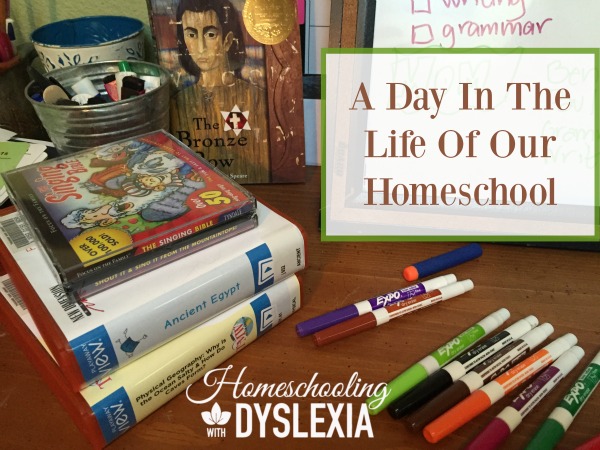
I love talking about homeschooling kids with dyslexia. That is because I believe so strongly in the freedom and flexibility that homeschooling provides for all families, regardless of how they learn.
However, if you’ve homeschooled for more than say, 5 minutes, you know that talking about homeschooling is much different than actually doing it!
Today I’m going to share with you a day in the life of our homeschool. I’m not posting our ideal schedule because, honestly, we are never able to stick to that plan in its entirety in any single day. Flexibility, mamas!
Meet the Family
We have 8 kids and have been homeschooling for over 20 years! Three kids have graduated, one is graduating this year and is largely independent. Hello math tutor!
That leaves us with:
- 7th grader
- 6th grader
- 3rd grader
- Kindergarten

A Day in the Life of Our Homeschool
5:30am: Alarm sounds. My husband and I get up early to get him on the road before traffic picks up in earnest.
6:00am: Today we work on a few invoices while having our morning detox shake. As an ‘older’ mom it is super important for me to stay fit and healthy. How else to keep up with those two rambunctious little boys! I do miss my morning coffee though.
6:30am: Hubby is off to work with our 18-year old son who is taking a year off of school to work in our family business after graduating high school last year.

7:00am: Kids are in various stages of waking up. I get dressed and update our dry erase board checklist. I find this visual aid right in the middle of the major living areas of our house invaluable to keeping track of what everyone is supposed to be doing. Tip: Use the check boxes and forbid erasing of anything! I found my kids with executive function weaknesses were erasing tasks before completing them. Then of course, we both forgot about that task. No erasing! Check the box please!
7:30am: Kids are all up and doing their morning chores. I pop some motivating music on the bluetooth speaker while I alternate between checking email and chore progress.
8:30am: Morning Time: I laughed as I wrote the time for this part of our day because inevitably one or more kids are not ready to sit down for this part of our day. Someone has forgotten to eat, pee or some other important daily task even though I have been declaring that we will all be sitting down in 5 minutes! Sigh…
We try to all sit down together at the beginning of each school day and do a few subjects together. There are some amazing resources for planning this time of day including Preschoolers and Peace Circle Time and Pam Barnill’s Your Morning Basket.
- Character Study: As Christians, our morning time today has starting with a short Bible study on gratitude. You did know that character training is a subject, right?We talk about glasses being half full or half empty and how practicing having an attitude of gratitude is good for them as well as mom!
Philippians 4:6 “do not be anxious about anything, but in everything by prayer and supplication with thanksgiving let your requests be made known to God.”
- Read Alouds: We listen to one chapter of The Bronze Bow while the little boys build with Zoobs, their latest passion. I let all of the kids do some quiet activity during our read aloud time. The older girls often do their handwriting or draw during this time. The boys (ages 8 and 5) go between Legos or Playmobil or Zoobs.
- Memory Work: All four of our younger kids participate in a Classical Conversations homeschool co-op. A large part of this is the weekly memory work in History, Science, English, Latin, Geography and Math. We review the past few weeks memory work via songs downloaded from the Classical Conversations web site. There is a lot of movement and singing during this time.
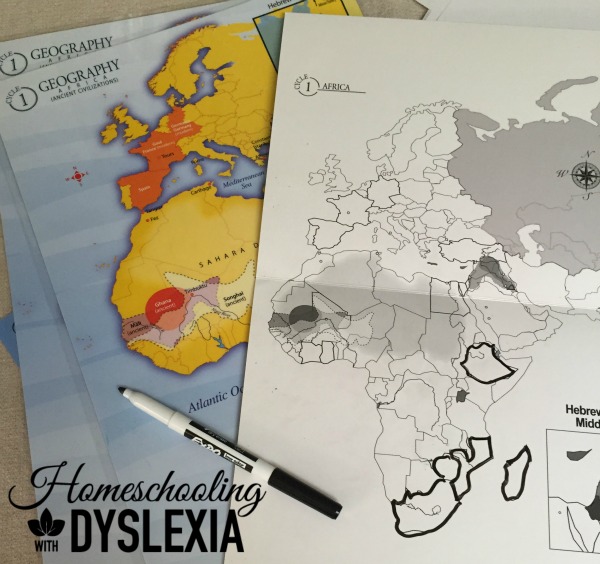
- One More Thing: I like to add one more thing to this ‘morning time’ if time permits. Maybe I will read more about the period of history or science topic we are learning about. Sometimes we’ll add in some extra art or nature study. Today is Valentine Park Day – a yearly tradition for our family. All kids bring a Valentine for each child in their grade. This morning the kids are finishing up their Valentines.

9:30am: Morning time is over for today. After a short break, the older girls refer to their lists and set about finishing as much of that list as possible. They are both using the computerized Math program Teaching Textbooks and only need my help occasionally. I highly recommend this resource. It’s like having the good Math teacher every year.
9:45am: Third Grade: I sit at the dining room table with my 8-year old, Ben. My 5-year old is driving his Zoob car around the house in some imaginary adventure. How nice it is to have him be at an age where I don’t have to watch him every second! In past years, I would always pair an older child with a younger one to help and keep an eye on them.
- Math: I am using Math U See for Math with Ben. He is still working at remembering his math facts so first we practice with Math-It. Math-It teaches tricks for remembering the facts and is multi-sensory. He lays the small flash cards on the answer board as he solves the equations in his head. We do a few pages of math. He loves solving the word problems at the end of each lesson. I still need to read all of them to him.
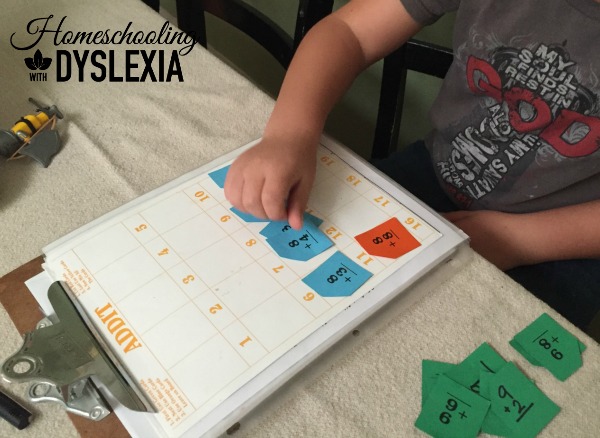
- Reading: I pull out my notes from our last reading lesson. I always try to write down how he did on his last lesson and specific things to work on the next day. He is in Level 2 of All About Reading. The readers are getting harder for him and so today I step back from having him read his reader and have hime build some of the words from the story on our magnetic board followed by rereading the warm up sheet for that story. Note: Not so long ago, when I had all 8 kids at home and little guys running around, we hired a certified Orton-Gillingham tutor to teach reading to our kids with dyslexia. Now that life has settled down some and since I went through the training to become an Orton-Gillingham tutor, I teach reading myself.
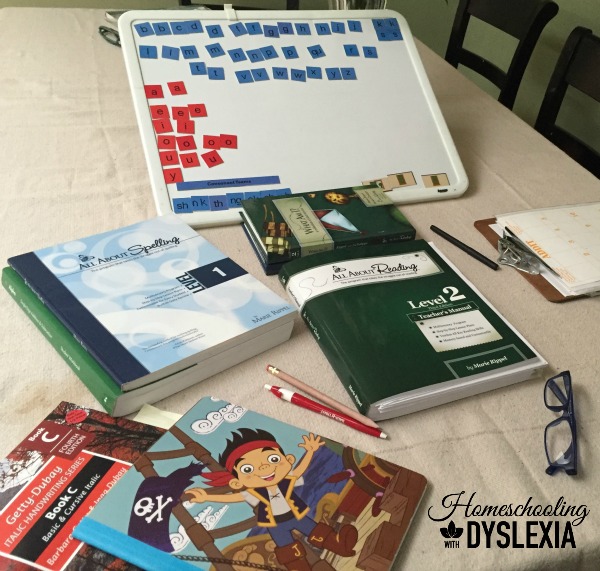
- Spelling: Using All About Spelling has been an easy and natural way for this little guy to practice encoding the words he has been decoding for some time. I pull out one of his readers from All About Reading Level 1 for review. After struggling with his current Level 2 reader, he is super excited at how easy his Level 1 reader is to read. Yay for progress!
10:45am: Time for a break. I move the daily load of laundry to the dryer and make a cup of tea. I check in with the girls and their lists. Using lists is great but because about 40-50% of kids with dyslexia also have ADD or ADHD, I have to provide the support that these kids need to keep on track.
11:00am: Kindergarten. I’m going to share one of my homeschool secrets with you. Are you ready? Shhhh….Kindergarten only takes 30 minutes. Tops! I’m serious. Here’s what our typical day of Kindergarten looks like.
- Phonics: After observing the early signs of dyslexia in 7 of my 8 kids over the past 25 years of parenting, I have recognized some of these signs in my youngest, Paul. We worked last year on the All About Reading Pre-Reading Program so he’s had lots of practice working with sounds and building his phonemic awareness skills. We are currently in Level 1 of All About Reading (it isn’t recommended to begin All About Spelling until after finished with Level 1 of AAR). We move slowly through his lessons. He knows his letter sounds and we are practicing blending the sounds into words.
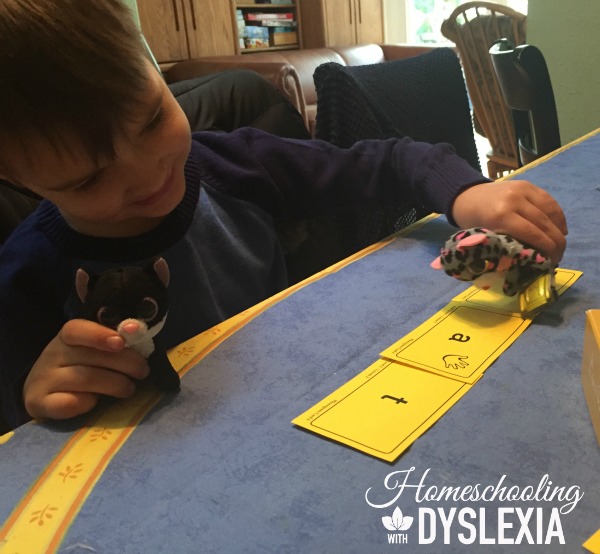
- Math: We use Math U See with all of our younger kids until they are ready to start 3rd grade math. Notice I didn’t say until they are in 3rd grade. All kids learn and develop at different rates. Some kids will do 3rd grade curriculum in 3rd grade, some in 2nd and some in 4th. This is normal. It is important to keep your focus on progress.
There was a time when this little guy wanted to do everything that his older brother did and so we acquired a variety of math manipulatives, toys and dry erase books for him to ‘work on’ at the table while I worked with his older brother. Not so much any more. He knows his time is coming and usually prefers to play until his time for school with mom.
11:30am: It’s been a fairly successful morning and we are all ready for a break. I check the lists again to see if anyone needs some nudging from mom. I take some time to answer a few emails. I’m working on a new children’s book and this site is getting a subtle redesign to make it easier for people to navigate and find the information they need.
On busy days, I’ll ask my 12-year old to make lunch. She is an excellent cook and enjoys preparing food for the family. Today we’re having left over pasta from last night. Easy!
12:30pm: The boys are outside playing. How could they be finished with school so soon? Is that it? Guess what? Research shows that play is vital for a child’s development. Kids learn so much just through play. Here are a few things our boys have learned just today:
- how to get along with others
- how to build forts (and all the thinking that that requires)
- pretend they are a character from our read aloud
- how to occupy themselves even when they claim to be bored
1:00pm: We pack up our water bottles, snacks and Valentines and head to a local park for our homeschool group’s Valentine’s Day celebration.
Normally, I would take the next hour to hour and a half to work with my 6th & 7th graders. This is what that schedule usually looks like:
Writing and Grammar with the 6th and 7th graders. I’ll write more about our experience with Classical Conversations (CC) in another post. For those of you in the know, our 7th grader could be in the junior high level of CC called Challenge A. We opted to have her complete one more year of Foundations and Essentials so that she was better prepared for the rigors of Challenge.
- Writing: We’re using Institute for Excellence in Writing for the 2nd year. It is part of our CC program. I love how the kids are challenged each week to learn something new and apply it to their writing. This week we are working on creative writing. Because we are studying Ancient History and Ancient Rome in particular at the moment, the girls are outlining and writing two paragraphs on what they would miss if they lived in Ancient times. They bring me their rough drafts and I help them with punctuation, spelling and adding the ‘dress ups’ that make their papers really shine.

- Grammar: Classical Conversations takes a dialectic approach to teaching English Grammar. Through examples and conversation kids are challenged to understand some pretty in depth terms. So far both of our kids are doing well with this and I am learning a ton as well too!
Getting it All Done
I go through the dry erase check list with each kid as they come to me saying that they’re finished. I double check papers, and assignments before letting the kids ‘off’ of their studies for the day.
We do allow computer time, twice a week, once school is finished. Otherwise the kids get busy with whatever projects they are currently interested in. These vary right now from video editing, crafting, cooking, fort building, writing stories, games and soccer.
It is pretty common in homeschooling to wonder if we’re getting enough done? A look through our schedule today may seem like we should have done more school. I have found that there are times when we get a lot done and other times where school is lighter. These phases can last for days, weeks or years depending on our family circumstances.
For more information on scheduling and the nuts and bolts of homeschooling, please see:
Homeschooling Kids With Dyslexia: Am I Doing Enough?
Creating a Homeschool Schedule That Really Works
How about you? How do you organize your homeschool days?






I loved this post as a glimpse into your day, mine is probably fairly similar, however, I only have two. A 15 year old and a 10 year old. I try to combine subjects where I can, and we do a lot of read aloud, history, literature, geography etc. After reading this article, I tried your whiteboard checklist – what a great idea, I used it all last week and it was amazing, the difference in attitude! Teaching kids with dyslexia is much more teacher intensive, and your time has to be divided among all.
Schedules are always an area I struggle with, I think I put too much into them and then stress when I don’t get everything done! It is one of the areas I am really trying to work on. I am busy reading a fabulous book “Teaching from Rest – A Homeschooler’s Guide to Unshakable Peace” – by Sarah Mackenzie, it is probably one of the best books I have read on the subject, I highly recommend it. Thank you Marianne for the wonderful work you do.
Thank you for sharing your day. I have two kiddos with dyslexia and dysgraphia and one, who I am pretty positive, has dycalcula. I enjoy seeing how other people structure their days and what materials they are using. 🙂 We have moved into a much more unschooling/project -based approach (which has been extremely tough for the type A part of me) but I have found my kids reading and writing a lot more this way. I like your white board check off too. I may add that one to our kitchen as well. 🙂
Enjoyed this day in the life post. Love your whiteboard organization and your character study. We read The Bronze Bow last year. It’s a great story. As for wondering if we get enough done, I have stopped worrying about it! I know my kids are learning just by living life and our formal lessons are an added bonus. 🙂
I have a 10 year old with dyslexia/dysgraphia/adhd, a 7 year old who is very advanced but has some problems with writing, and a 4 year old. We do read alouds and vocabulary a.m. day memorization during breakfast. Then daily chores. Then an hour of the stuff they hate (braintraining, writing, grammar, spelling…) then an hour of lighter work (game schooling, science experiments, library trip, or “opportunity time” where they pick what they want to work on). After lunch and some time outside, we do reading siesta where everyone reads (I alternate who I check in with), then a snack, then another hour or so of school (math, writing, history, science… whatever I feel we need to work on). Everyone gets a turn on the iPad for educational games a couple times during the week. And we end the day with a worship song.
Thanks for sharing Angela. That sounds like a wonderful schedule! 🙂
I’m interested in getting certified to tutor my son but I’m getting conflicting information about it. Where do you recommend getting certified?
The person with dyscalculia is myself. If you have kids that dyslexic keep working on reading even after they graduate from high school . Also spelling too. My spelling has gotten much worse. Because I don’t see patterns when it comes to spelling or math. Just very simple workbook will help with math. So they don’t forget any necessary skills. Even as adults we still feel dumb. I apologize for my many mistakes in punctuation.